Accurate Stride-Length Estimation Based on LT-StrideNet for Pedestrian Dead Reckoning Using a Shank-Mounted Sensor
Abstract
1. Introduction
- (1)
- A new deep-learning model based on LSTM and Transformer, LT-StrideNet, is proposed to estimate pedestrian-stride length.
- (2)
- A shank-mounted PDR framework is provided, which is a supplementary scheme to the foot-mounted PDR.
- (3)
- Tests were completed using the our self-developed IMU module, including indoor and outdoor positioning.
2. Materials and Methods
2.1. Stride-Length-Estimation Method Based on LSTM and Transformer
2.1.1. Segmentation of Sensor Data
2.1.2. The Deep-Learning Model for Stride-Length Estimation
2.1.3. The Training of Stride-Length-Estimation Model
| Algorithm 1: The proposed stride-length-estimation method |
| Input: training data with actual stride length, test data without actual stride length Output: the estimated stride length 1//Data preprocessing 2 for each stride 3 Split the sensor data according to the stride event 4 Extract the sensor data and actual length of each stride 5 Expand or compress the sensor data to a fixed size 6 end for 7//Model training 8 Build and train the stacked LSTM–Transformer model shown in Figure 2 using the training dataset 9 Save the trained model 10//Model test 11 Predict the pedestrian-stride length using the saved model |
2.2. The PDR Framework with Proposed Stride-Length-Estimation Method
2.2.1. Sensor-Error Calibration
2.2.2. Stride-Detection Method
2.2.3. EKF-Based Heading Estimation
2.2.4. The Initial Attitude Alignment
3. Experiments and Results
3.1. Introduction to the IMU Module
3.2. Training of Our Stride-Length-Estimation Model
3.3. Collection of Experimental Data for Pedestrian Positioning
3.4. Experimental Results
3.4.1. Results of Stride Detection and Stride-Length Estimation
3.4.2. Results of Indoor Positioning
3.4.3. Results of Outdoor Positioning
4. Discussion
4.1. Evaluation of Experimental Results
4.2. Comparison with Related Works
5. Conclusions
Author Contributions
Funding
Data Availability Statement
Conflicts of Interest
References
- Zhao, H.; Cheng, W.; Yang, N.; Qiu, S.; Wang, Z.; Wang, J. Smartphone-Based 3D Indoor Pedestrian Positioning through Multi-Modal Data Fusion. Sensors 2019, 19, 4554. [Google Scholar] [CrossRef]
- Yu, C.; Haiyong, L.; Fang, Z.; Qu, W.; Wenhua, S. Adaptive Kalman filtering-based pedestrian navigation algorithm for smartphones. Int. J. Adv. Robot. Syst. 2020, 17, 255687899. [Google Scholar] [CrossRef]
- Mazzà, C.; Alcock, L.; Aminian, K.; Becker, C.; Bertuletti, S.; Bonci, T.; Brown, P.; Brozgol, M.; Buckley, E.; Carsin, A.; et al. Technical validation of real-world monitoring of gait: A multicentric observational study. BMJ Open 2021, 11, e50785. [Google Scholar] [CrossRef]
- Noureldin, A.; El-Shafie, A.; Bayoumi, M. GPS/INS integration utilizing dynamic neural networks for vehicular navigation. Inform. Fusion 2011, 12, 48–57. [Google Scholar] [CrossRef]
- Niu, X.; Liu, T.; Kuang, J.; Li, Y. A Novel Position and Orientation System for Pedestrian Indoor Mobile Mapping System. IEEE Sens. J. 2021, 21, 2104–2114. [Google Scholar] [CrossRef]
- Despaux, F.; van den Bossche, A.; Jaffrès-Runser, K.; Val, T. N-TWR: An accurate time-of-flight-based N-ary ranging protocol for Ultra-Wide band. Ad Hoc Netw. 2018, 79, 1–19. [Google Scholar] [CrossRef]
- Simran, B.; Peng, W. Crowdsensing-based WiFi Indoor Localization using Feed-forward Multilayer Perceptron Regressor. In Proceedings of the 2019 International Conference on Computational Intelligence in Data Science (ICCIDS), Chennai, India, 21–23 February 2019; pp. 1–6. [Google Scholar]
- Husen, M.N.; Lee, S. Indoor Location Sensing with Invariant Wi-Fi Received Signal Strength Fingerprinting. Sensors 2016, 16, 1898. [Google Scholar] [CrossRef]
- Liu, S.; Jiang, Y.; Striegel, A. Face-to-Face Proximity EstimationUsing Bluetooth on Smartphones. IEEE Trans. Mob. Comput. 2014, 13, 811–823. [Google Scholar] [CrossRef]
- Li, Y.; Wang, L. Human Activity Recognition Based on Residual Network and BiLSTM. Sensors 2022, 22, 635. [Google Scholar] [CrossRef]
- Luo, J.; Zhang, C.; Wang, C. Indoor Multi-Floor 3D Target Tracking Based on the Multi-Sensor Fusion. IEEE Access 2020, 8, 36836–36846. [Google Scholar] [CrossRef]
- Jiang, C.; Chen, Y.; Chen, C.; Jia, J.; Sun, H.; Wang, T.; Hyyppa, J. Smartphone PDR/GNSS Integration via Factor Graph Optimization for Pedestrian Navigation. IEEE Trans. Instrum. Meas. 2022, 71, 8504112. [Google Scholar] [CrossRef]
- Zhao, Y.; Liang, J.; Cui, Y.; Sha, X.; Li, W.J. Adaptive 3D Position Estimation of Pedestrians by Wearing One Ankle Sensor. IEEE Sens. J. 2020, 20, 11642–11651. [Google Scholar] [CrossRef]
- Yao, Y.; Pan, L.; Fen, W.; Xu, X.; Liang, X.; Xu, X. A Robust Step Detection and Stride Length Estimation for Pedestrian Dead Reckoning Using a Smartphone. IEEE Sens. J. 2020, 20, 9685–9697. [Google Scholar] [CrossRef]
- Renaudin, V.; Susi, M.; Lachapelle, G. Step Length Estimation Using Handheld Inertial Sensors. Sensors 2012, 12, 8507–8525. [Google Scholar] [CrossRef] [PubMed]
- Weinberg, H. Using the ADXL202 in pedometer and personal navigation applications. In Analog Devices AN-602 Application Note; Analog Devices: Norwood, MA, USA, 2002; Volume 2, pp. 1–6. [Google Scholar]
- Hajati, N.; Rezaeizadeh, A. A Wearable Pedestrian Localization and Gait Identification System Using Kalman Filtered Inertial Data. IEEE Trans. Instrum. Meas. 2021, 70, 2507908. [Google Scholar] [CrossRef]
- Shao, W.; Zhao, F.; Luo, H.; Tian, H.; Li, J.; Crivello, A. Particle Filter Reinforcement via Context-Sensing for Smartphone-Based Pedestrian Dead Reckoning. IEEE Commun. Lett. 2021, 25, 3144–3148. [Google Scholar] [CrossRef]
- Krizhevsky, A.; Sutskever, I.; Hinton, G.E. ImageNet classification with deep convolutional neural networks. Adv. Neural Inf. Process. Syst. 2012, 25, 84–90. [Google Scholar] [CrossRef]
- Sutskever, I.; Vinyals, O.; Le, Q.V. Sequence-to-sequence-learning-with-neural-networks. Adv. Neural Inf. Process. Syst. 2014, 27, 1–9. [Google Scholar]
- Gu, F.; Khoshelham, K.; Yu, C.; Shang, J. Accurate Step Length Estimation for Pedestrian Dead Reckoning Localization Using Stacked Autoencoders. IEEE Trans. Instrum. Meas. 2019, 68, 2705–2713. [Google Scholar] [CrossRef]
- Wang, Q.; Ye, L.; Luo, H.; Men, A.; Zhao, F.; Huang, Y. Pedestrian Stride-Length Estimation Based on LSTM and Denoising Autoencoders. Sensors 2019, 19, 840. [Google Scholar] [CrossRef]
- Klein Itzik, O.A. StepNet-Deep Learning Approaches for Step Length Estimation. IEEE Access 2020, 8, 85706–85713. [Google Scholar] [CrossRef]
- Hou, X.; Bergmann, J. A Pedestrian Dead Reckoning Method for Head-Mounted Sensors. Sensors 2020, 20, 6349. [Google Scholar] [CrossRef]
- Hasan, M.A.; Mishuk, M.N. MEMS IMU Based Pedestrian Indoor Navigation for Smart Glass. Wirel. Pers. Commun. 2018, 101, 287–303. [Google Scholar] [CrossRef]
- Hochreiter, S.; Schmidhuber, J. Long Short-Term Memory. Neural Comput. 1997, 9, 1735–1780. [Google Scholar] [CrossRef]
- Vaswani, A.; Shazeer, N.; Parmar, N.; Uszkoreit, J.; Jones, L.; Gomez, A.N.; Kaiser, A.; Polosukhin, I. Attention Is All You Need. In Neural Information Processing Systems; MIT Press: Cambridge, MA, USA, 2017; pp. 5998–6008. [Google Scholar]
- Wu, D.; Xia, L.; Geng, J. Heading Estimation for Pedestrian Dead Reckoning Based on Robust Adaptive Kalman Filtering. Sensors 2018, 18, 1970. [Google Scholar] [CrossRef]
- Zhao, H.; Wang, Z.; Qiu, S.; Shen, Y.; Zhang, L.; Tang, K.; Fortino, G. Heading Drift Reduction for Foot-Mounted Inertial Navigation System via Multi-Sensor Fusion and Dual-Gait Analysis. IEEE Sens. J. 2019, 19, 8514–8521. [Google Scholar] [CrossRef]
- Hsu, Y.; Wang, J.; Chang, C. A Wearable Inertial Pedestrian Navigation System with Quaternion-Based Extended Kalman Filter for Pedestrian Localization. IEEE Sens. J. 2017, 17, 3193–3206. [Google Scholar] [CrossRef]
- Li, J.; Liu, X.; Wang, Z.; Zhao, H.; Zhang, T.; Qiu, S.; Zhou, X.; Cai, H.; Ni, R.; Cangelosi, A. Real-Time Human Motion Capture Based on Wearable Inertial Sensor Networks. IEEE Internet Things J. 2022, 9, 8953–8966. [Google Scholar] [CrossRef]
- Bai, N.; Tian, Y.; Liu, Y.; Yuan, Z.; Xiao, Z.; Zhou, J. A High-Precision and Low-Cost IMU-Based Indoor Pedestrian Positioning Technique. IEEE Sens. J. 2020, 20, 6716–6726. [Google Scholar] [CrossRef]
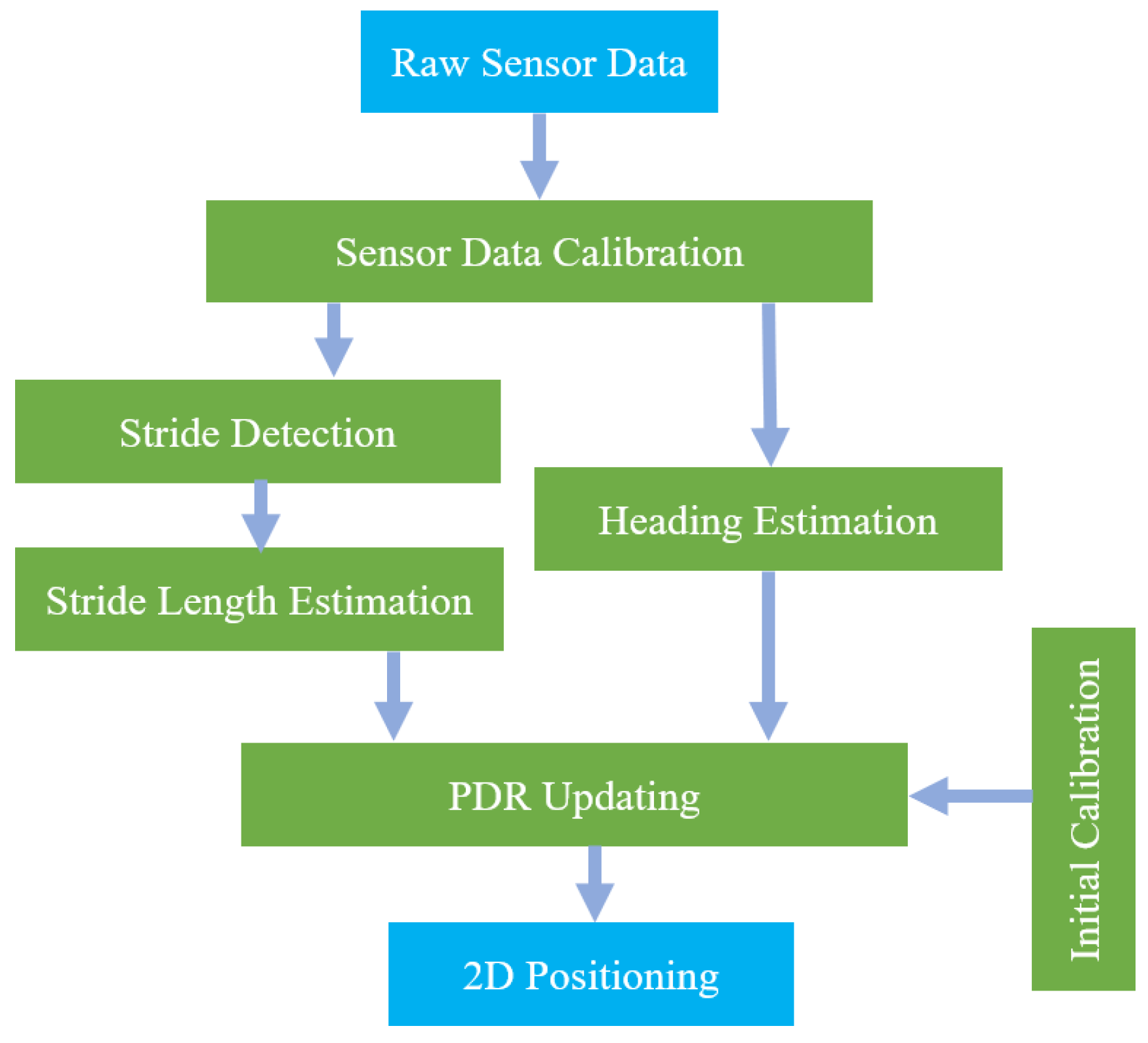

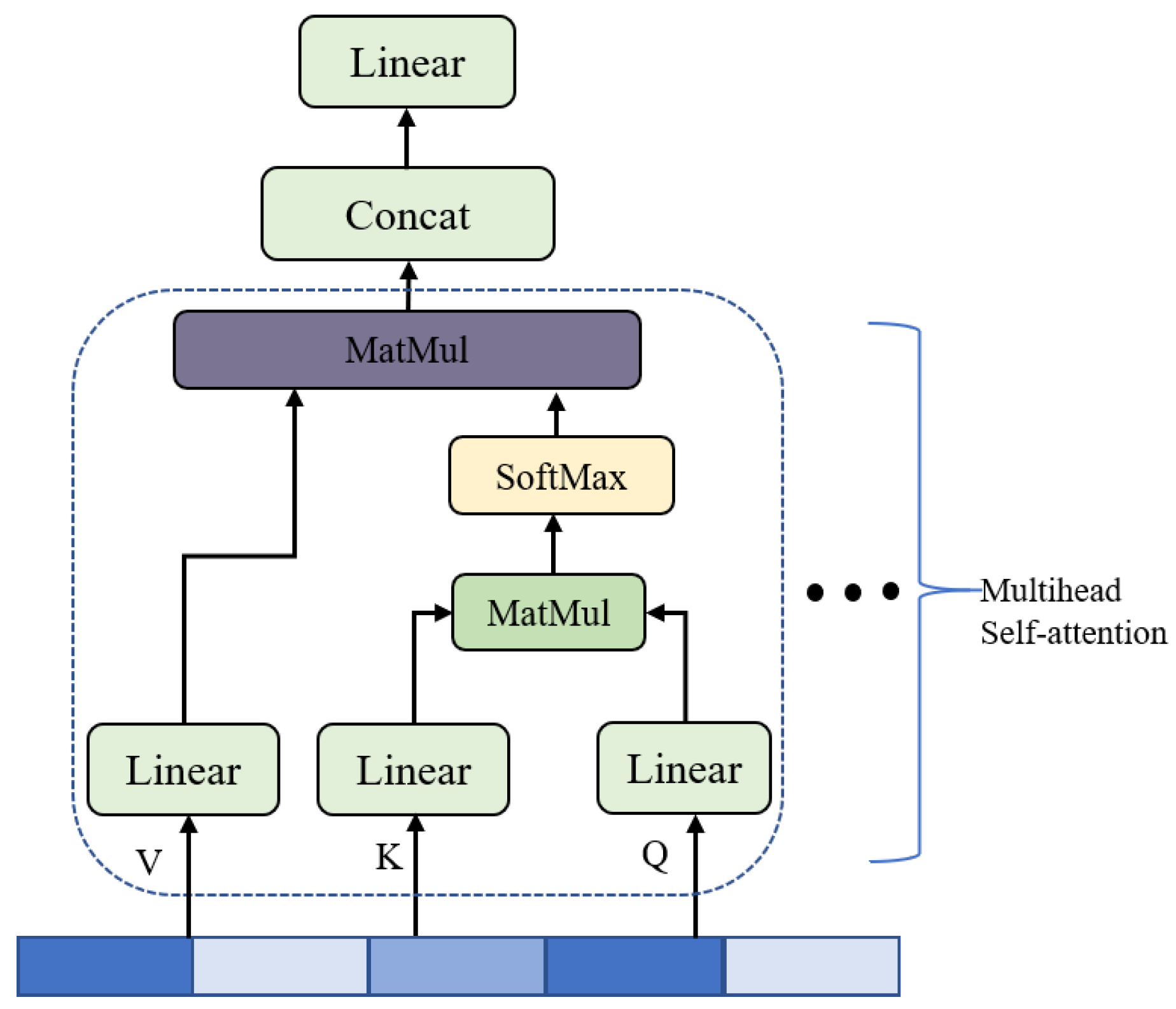

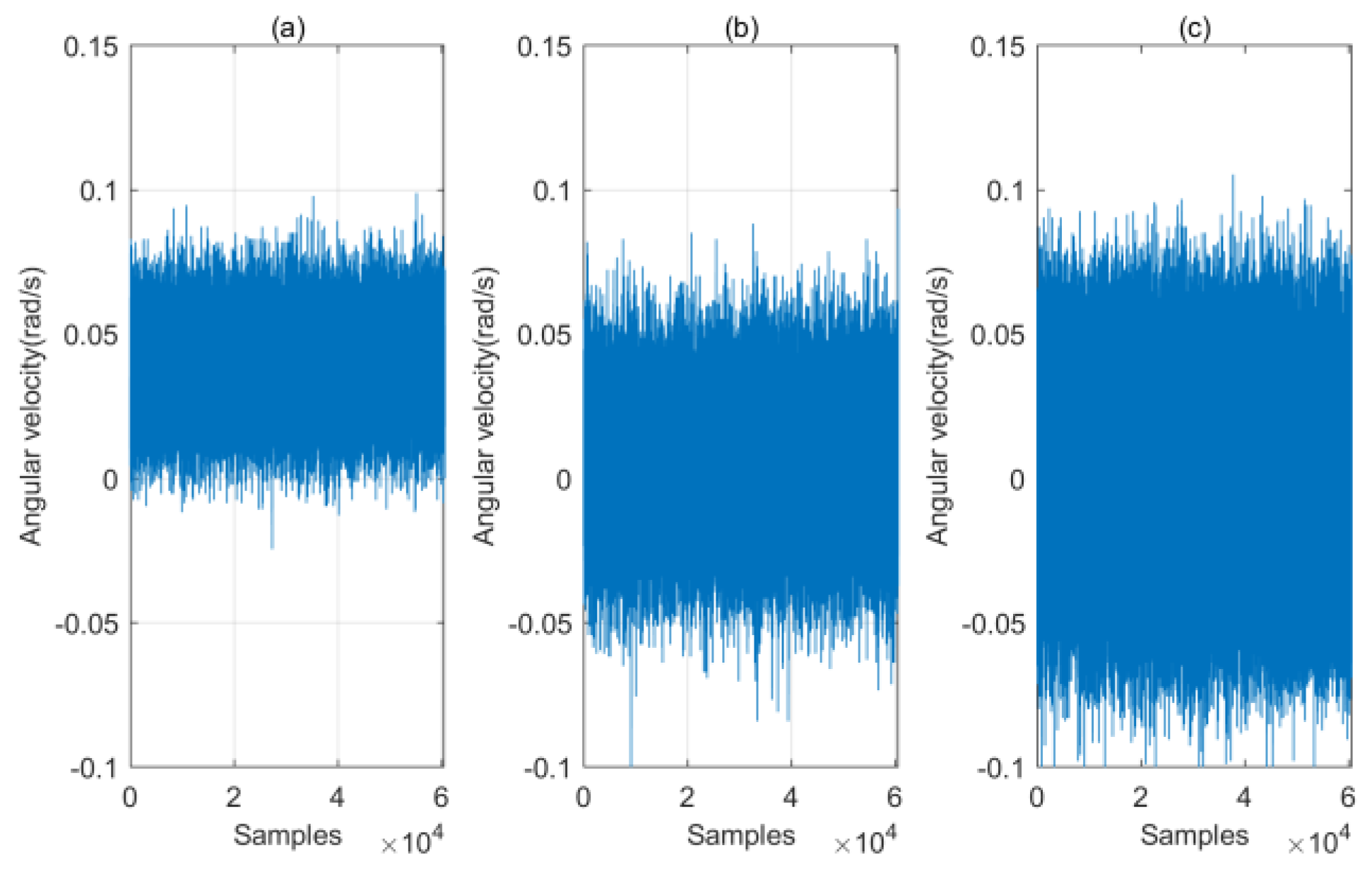
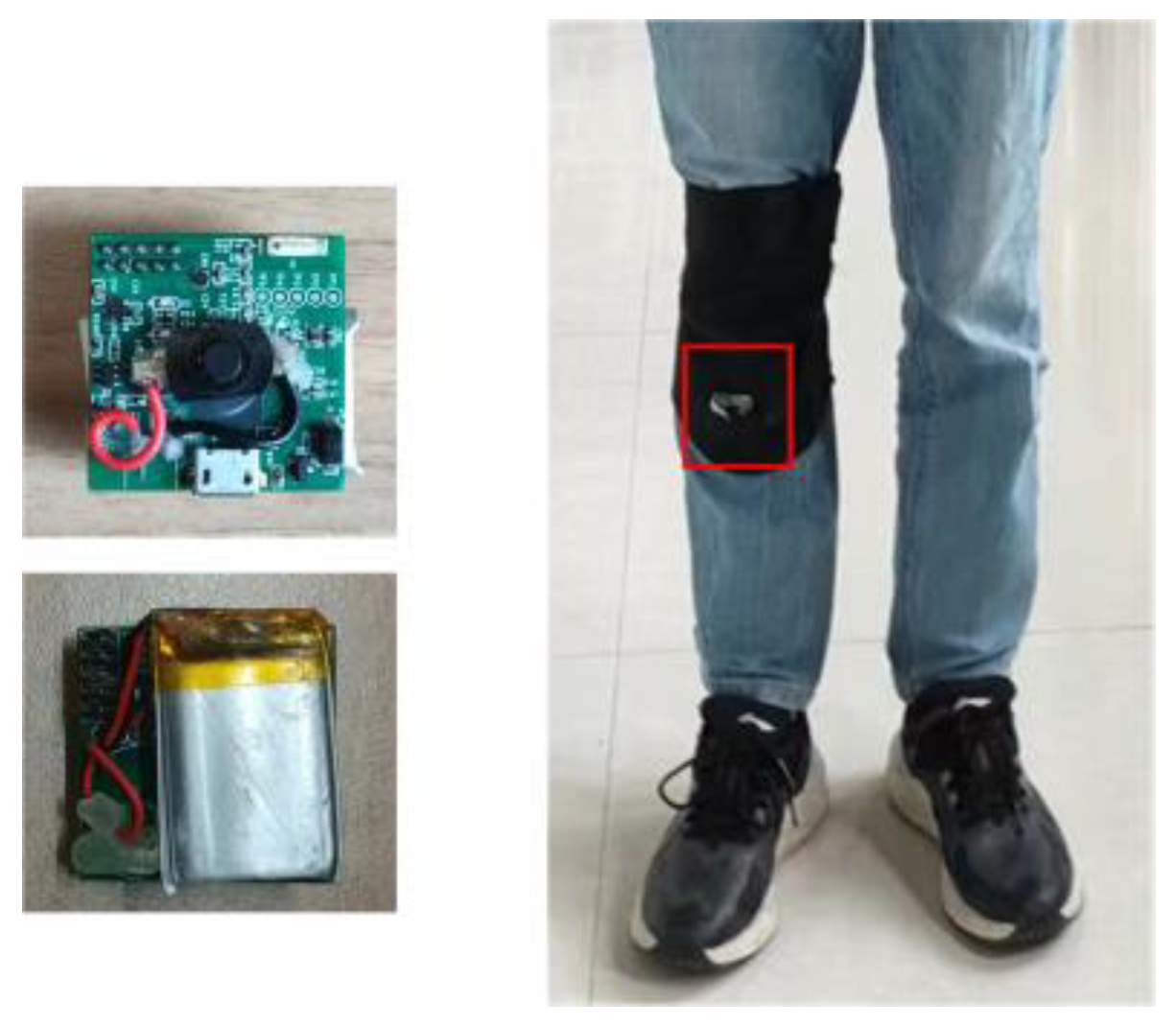
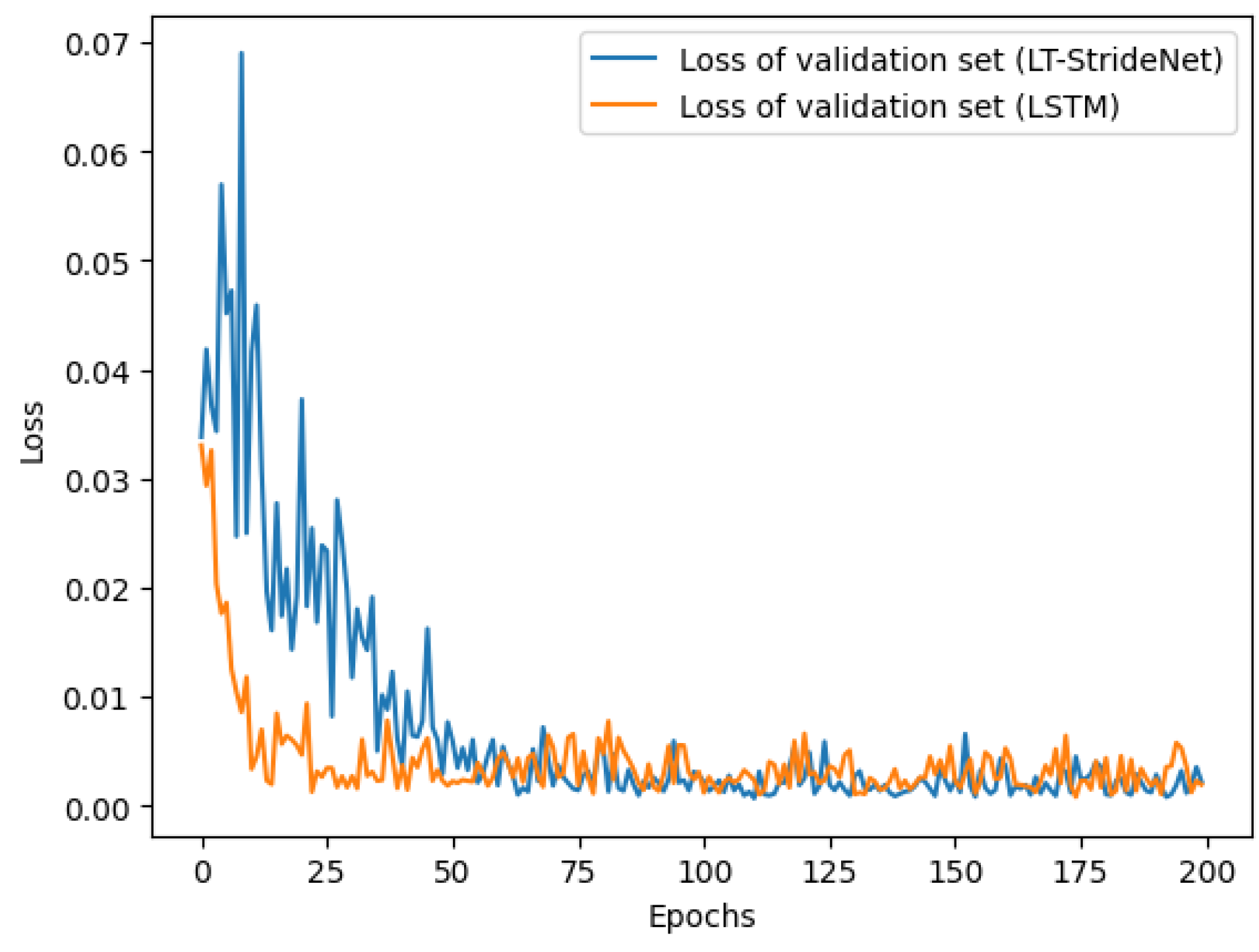
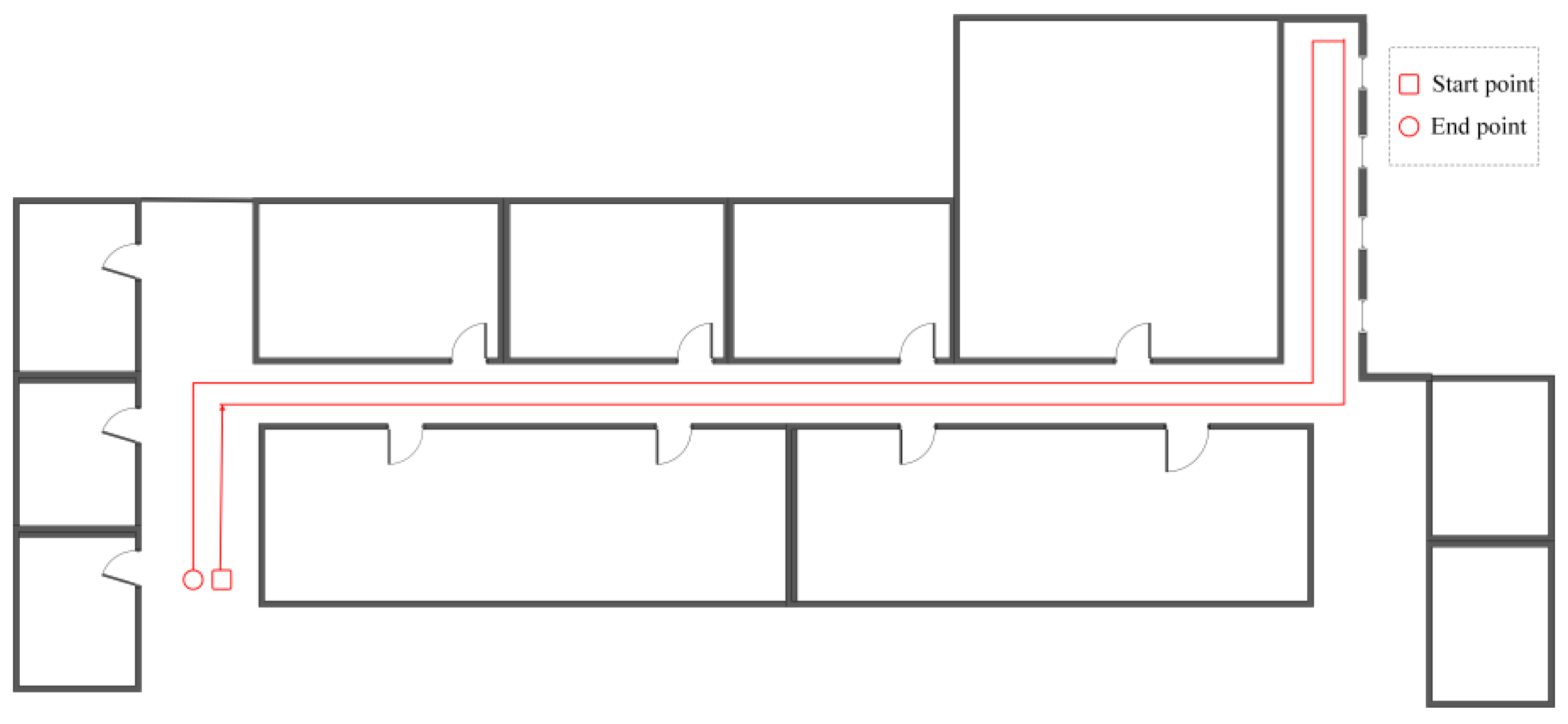
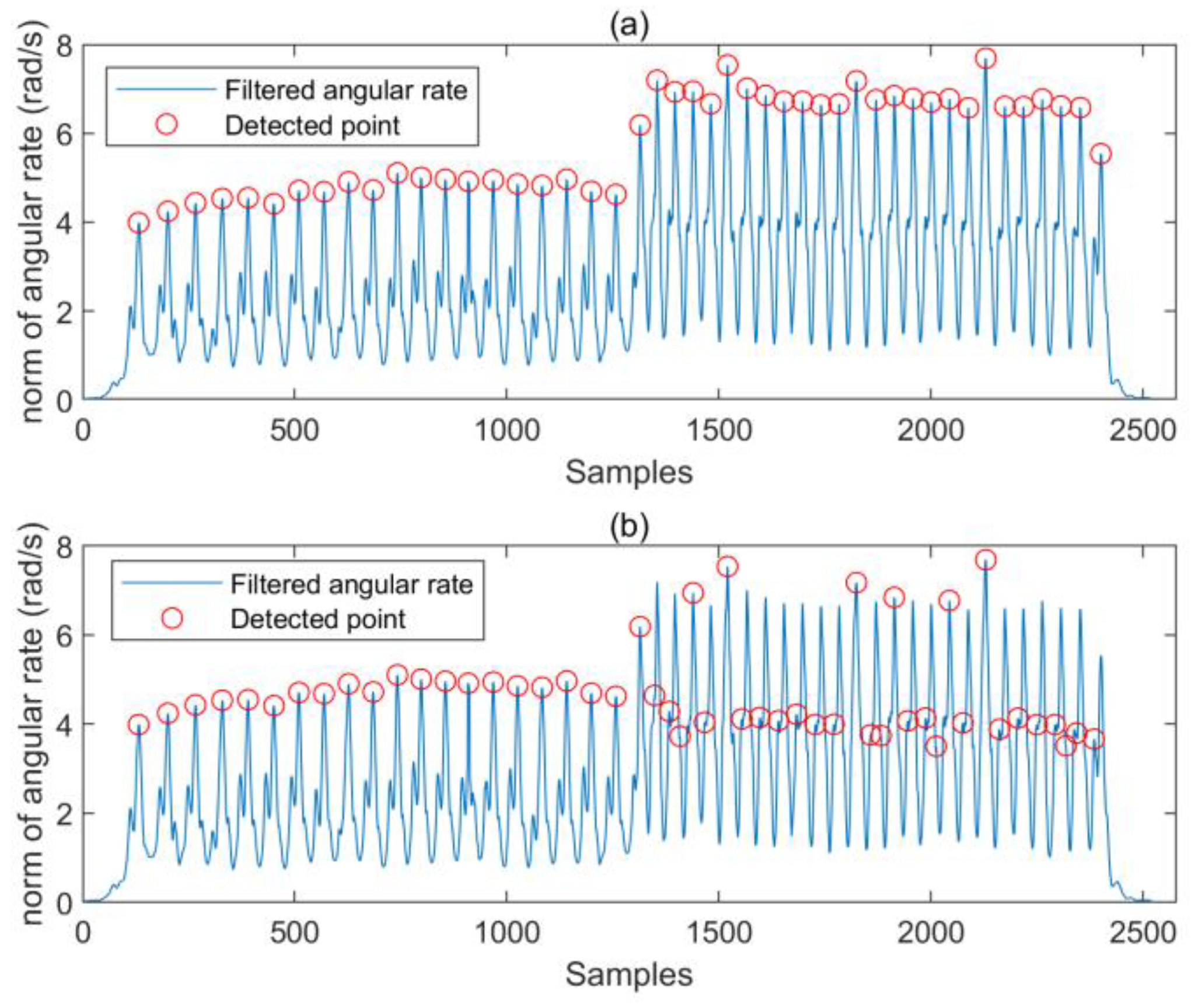
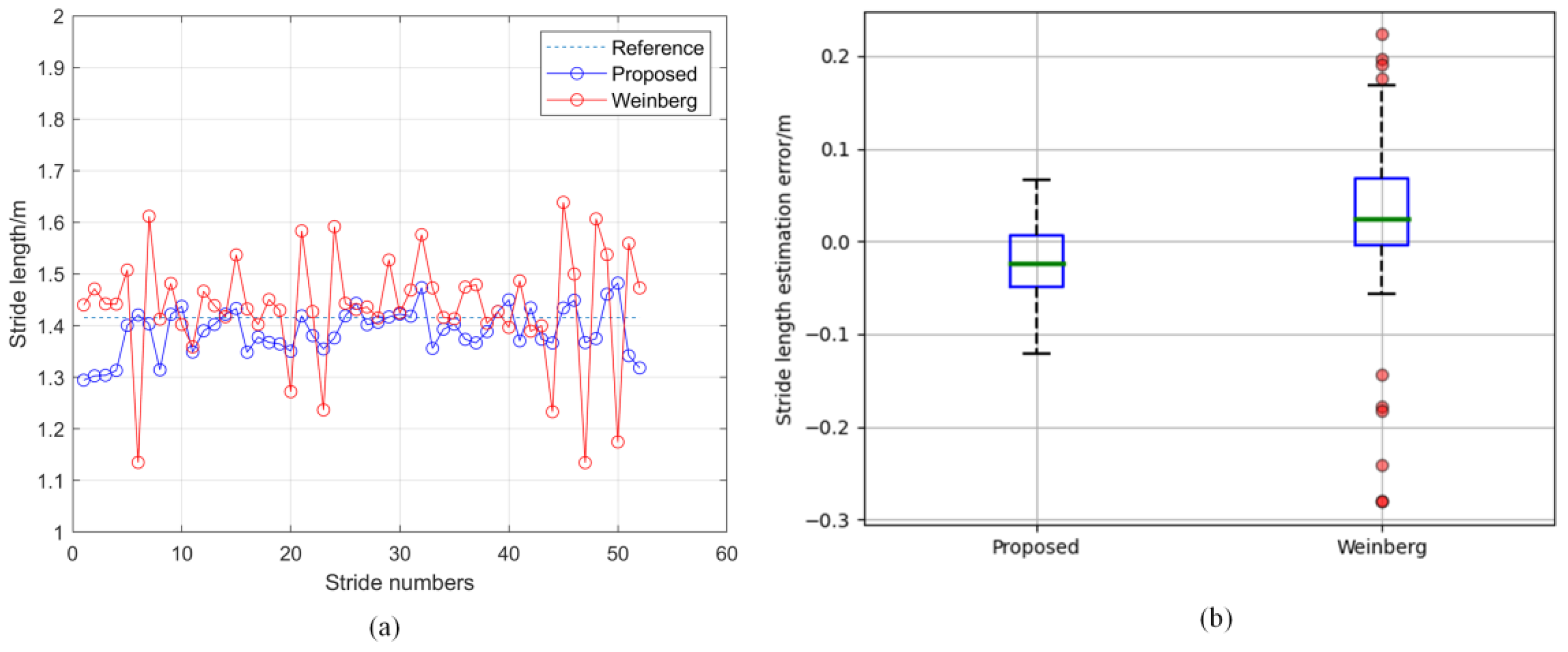
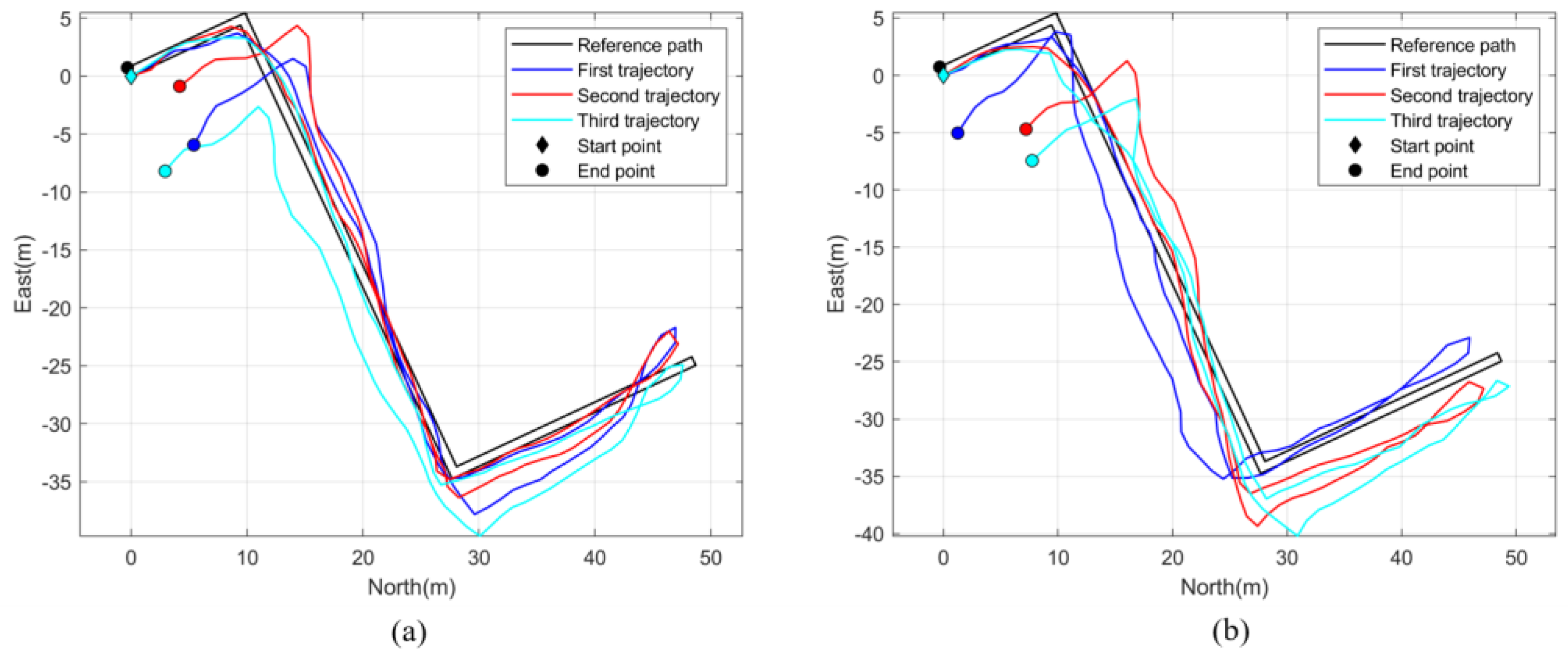
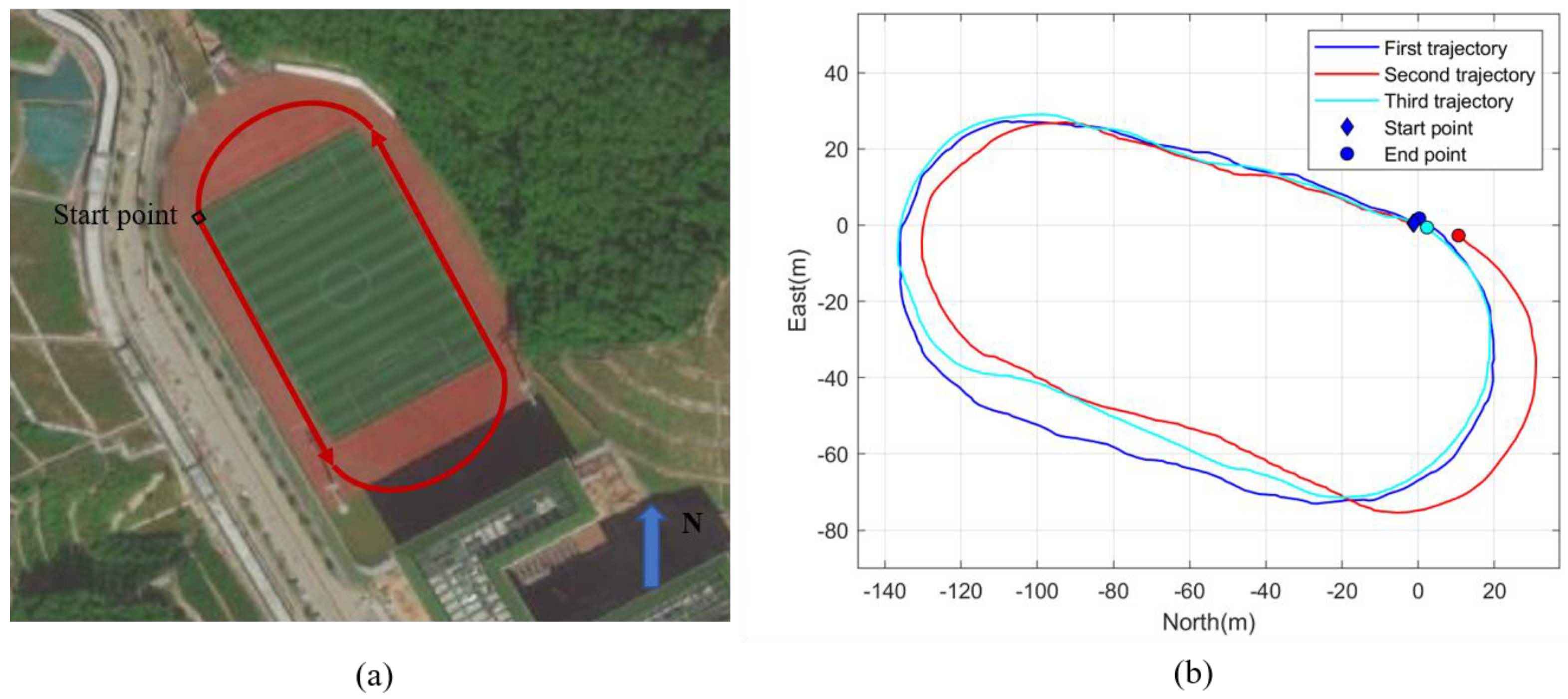
| Sensor | Accelerometer | Gyroscope | Magnetometer |
|---|---|---|---|
| Dimensions | 3 axes | 3 axes | 3 axes |
| Dynamic range | ±8 g | ±2000 dps/s | ±4800 uT |
| Bandwidth (Hz) | 50 | 50 | 10 |
| Nonlinearity (%) | ±0.5 | ±0.1 | ±0.5 |
| Noise density | 400 | 0.01 °/s/ | - |
| Bias stability | 160 | 74 °/h | - |
| Volunteers | Height (m) | Age | Weight (kg) | |
|---|---|---|---|---|
| 1 | 1.78 | 33 | 67 | 0.77 |
| 2 | 1.75 | 25 | 75 | 0.82 |
| 3 | 1.72 | 25 | 60 | - |
| 4 | 1.68 | 24 | 65 | - |
| Parameters | Value |
|---|---|
| Number of trajectories | 52 |
| Number of total data segments | 1843 |
| Number of data segments for walking slowly | 718 |
| Number of data segments for walking normally | 601 |
| Number of data segments for walking quickly | 524 |
| Hyperparameters | Value |
|---|---|
| Number of LSTM cells per hidden layer | 32 |
| Number of LSTM layers | 2 |
| Number of Transformer-encoder layers | 2 |
| Number of heads per Transformer-encoder layer | 4 |
| Dropout | 0.3 |
| Loss function | MSE |
| Learning rate | 0.001 |
| Batch size | 32 |
| Optimizer | Adam |
| Epochs | 200 |
| Proposed PDR Method | PDR with Weinberg Model | |||||||||
|---|---|---|---|---|---|---|---|---|---|---|
| Vol. No. | Trial No. | NAS | NDS | SE (%) | TD (m) | ED (m) | DE (%) | ED (m) | DE (%) | WS |
| 1 | 1 | 70 | 69 | 1.4 | 94.4 | 98.2 | 4.0 | 104.5 | 10.2 | WS |
| 2 | 68 | 68 | 0 | 94.4 | 99.1 | 5.0 | 104.2 | 10.3 | WS | |
| 3 | 66 | 66 | 0 | 94.4 | 97.2 | 2.9 | 103.7 | 9.8 | WN | |
| 4 | 65 | 65 | 0 | 94.4 | 94.3 | 0.1 | 100.9 | 6.8 | WN | |
| 5 | 58 | 58 | 0 | 94.4 | 96.4 | 2.1 | 97.6 | 3.3 | WQ | |
| 6 | 56 | 56 | 0 | 94.4 | 91.97 | 2.5 | 93.4 | 1.0 | WQ | |
| 2 | 1 | 73 | 71 | 2.7 | 94.4 | 92.5 | 2.0 | 105.1 | 11.3 | WS |
| 2 | 70 | 69 | 1.4 | 94.4 | 98.1 | 3.9 | 108.2 | 14.6 | WS | |
| 3 | 65 | 65 | 0 | 94.4 | 96.3 | 2.0 | 101.7 | 7.7 | WN | |
| 4 | 64 | 64 | 0 | 94.4 | 97.5 | 3.2 | 101.1 | 7.1 | WN | |
| 5 | 53 | 53 | 0 | 94.4 | 93.2 | 1.2 | 90.2 | 4.4 | WQ | |
| 6 | 54 | 54 | 0 | 94.4 | 91.9 | 2.6 | 91.1 | 3.5 | WQ | |
| Mean | 0.5 ± 0.9 | 2.6 ± 1.3 | 7.5 ± 3.9 | |||||||
| Volunteers No. | Trial No. | Stride Count | EE (%) | DE (%) | ||
|---|---|---|---|---|---|---|
| Actual | Detected | SE (%) | ||||
| 1 | 1 | 123 | 123 | 0 | 5.7 | 2.6 |
| 2 | 124 | 125 | 0.8 | 3.1 | 3.1 | |
| 3 | 124 | 124 | 0 | 6.2 | 2.5 | |
| 2 | 1 | 116 | 117 | 0.8 | 3.8 | 2.9 |
| 2 | 121 | 121 | 0 | 6.0 | 4.4 | |
| 3 | 125 | 127 | 1.6 | 7.4 | 2.2 | |
| Mean | - | - | - | 0.5 ± 0.7 | 5.4 ± 1.6 | 3.0 ± 0.8 |
| Volunteers No. | Trail No. | Stride Count | EE (%) | DE (%) | ||
|---|---|---|---|---|---|---|
| Actual | Detected | SE (%) | ||||
| 1 | 1 | 303 | 301 | 0.6 | 0.4 | 3.5 |
| 2 | 281 | 278 | 1.0 | 2.7 | 1.0 | |
| 3 | 285 | 283 | 0.7 | 0.6 | 0.87 | |
| Mean | - | - | - | 0.8 ± 0.2 | 1.2 ± 1.3 | 1.8 ± 1.5 |
Disclaimer/Publisher’s Note: The statements, opinions and data contained in all publications are solely those of the individual author(s) and contributor(s) and not of MDPI and/or the editor(s). MDPI and/or the editor(s) disclaim responsibility for any injury to people or property resulting from any ideas, methods, instructions or products referred to in the content. |
© 2023 by the authors. Licensee MDPI, Basel, Switzerland. This article is an open access article distributed under the terms and conditions of the Creative Commons Attribution (CC BY) license (https://creativecommons.org/licenses/by/4.0/).
Share and Cite
Li, Y.; Zeng, G.; Wang, L.; Tan, K. Accurate Stride-Length Estimation Based on LT-StrideNet for Pedestrian Dead Reckoning Using a Shank-Mounted Sensor. Micromachines 2023, 14, 1170. https://doi.org/10.3390/mi14061170
Li Y, Zeng G, Wang L, Tan K. Accurate Stride-Length Estimation Based on LT-StrideNet for Pedestrian Dead Reckoning Using a Shank-Mounted Sensor. Micromachines. 2023; 14(6):1170. https://doi.org/10.3390/mi14061170
Chicago/Turabian StyleLi, Yong, Guopei Zeng, Luping Wang, and Ke Tan. 2023. "Accurate Stride-Length Estimation Based on LT-StrideNet for Pedestrian Dead Reckoning Using a Shank-Mounted Sensor" Micromachines 14, no. 6: 1170. https://doi.org/10.3390/mi14061170
APA StyleLi, Y., Zeng, G., Wang, L., & Tan, K. (2023). Accurate Stride-Length Estimation Based on LT-StrideNet for Pedestrian Dead Reckoning Using a Shank-Mounted Sensor. Micromachines, 14(6), 1170. https://doi.org/10.3390/mi14061170





